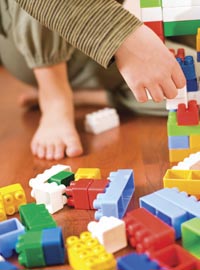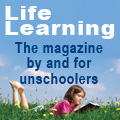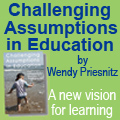Learning Through Play
By Beverley Paine
 As a child, I remember visiting friends who had LEGO®. The little interlocking bricks, with their precise engineering and clean lines, immediately appealed to me. I loved the tidy little houses with the opening doors and windows and smooth red roofs. Each birthday and Christmas I asked for LEGO only to be offered some other toy. I knew that one day I’d have children and they’d have LEGO! As a child, I remember visiting friends who had LEGO®. The little interlocking bricks, with their precise engineering and clean lines, immediately appealed to me. I loved the tidy little houses with the opening doors and windows and smooth red roofs. Each birthday and Christmas I asked for LEGO only to be offered some other toy. I knew that one day I’d have children and they’d have LEGO!
“Toy” is a rather a demeaning description of this clever manipulative construction material. My dictionary defines toy as something meant for amusement rather than serious use. LEGO serves both purposes. It is a plaything and can amuse for many hours, but the real value in this children’s toy comes from the hidden learning quietly happening behind all the play.
Anyone who has visited our house can attest to our apparent addiction to LEGO, with our ever expanding collection of plastic bricks reaching mind boggling dimensions. When April turned three she received her first LEGO car and trailer, a set that is still in almost complete condition. A LEGO tractor decorated the centre of Roger’s first birthday cake. By four he could quickly assemble sets using instructions in less than half the time of kids twice his age. Thomas has never known life without LEGO. Their huge collection gave them greater diversity of play and model building. As they grew they became extremely selective, choosing sets that enlarged the usability of their collection.
Although I valued play as a major component of an educational curriculum, I never fully understood why play is such a powerful learning medium. For years I slotted in school-type learning activities into my children’s highly imaginative and constructive play, often interrupting the flow and disturbing the game. My subtle emphasis on what I considered to be a more valuable use of time undermined the value of play. It took me a long time to realize that my children, when playing, were actively engaged in a superior form of learning, effortlessly and efficiently teaching themselves things that would take many hours with contrived lessons.
Play with LEGO encouraged manual dexterity and good hand-eye coordination, and helped with classification and spatial skills. I watched the children move from solitary play, to parallel play and then to cooperative play. I heard April dictate play scripts for Roger, and, as his confidence and assertiveness grew, watched how he became more involved in the organization and structure of the games. Play allowed them to role play and assimilate, in non-threatening and controlled ways, disturbing incidents in their own life. They built amazing models and scenes which duplicated things they’d recently seen. I watched them stretch their imaginations to devise simple and complex machines, setting themselves tasks that challenged them into new cognitive thresholds. They worked hard to earn the money they needed to continue building their LEGO collections, thus learning many new skills in different areas.
Life was always imitated in play. After a trip on an historic tram, Roger built an intricate model, complete with platform, track and overhead rails. A town grew up around this model and a game was played for days. A tour aboard a ship produced several sailing ships, built without instructions, using memory and imagination. The ensuing game needed islands, fortresses and towns and lasted more than a week, with intense periods of concentration and play.
It’s easy to dismiss this activity as simply playing. However, a game of pirates was incomplete without frequent reference to the encyclopedia or books from the library on the subject, complemented by a trek down to the video shop. The movie The Mutiny on the Bounty sparked discussion about Australian history; another model soon appeared, and Cap’n Roger became William Bligh. The children made swords from plywood; fierce battles were fought on and around the newly decorated cubby, an imaginary sailing ship. The technology and work skills used in such games goes well beyond the initial manipulation of little plastic bricks.
The most elaborate LEGO houses have adorned April’s floor. We began building our home a few months before her birth, and haven’t stopped building since. So it’s no wonder that April is an expert at LEGO house construction! It was a lovely surprise to arrive home one day to find she had built a to-scale model of our home, complete with furniture. Plans are integral to the building process. A model of a carnival, complete with Ferris-wheels and rides, resulted in a collection of maps and drawings, just in case they wanted to build it again.
As the children grew, model building replaced the more playful aspects of LEGO. The children stopped using their models to play games where characters live in a fantasy world and have adventures. But even at the age of 16, Roger still indulged his younger brother in such imaginative play. I was impressed by this social skill, one often lost by kids this age group keen to get on with more “adult” past-times. More than the others, Roger has used LEGO as a learning platform. He surprised us all with a prize-winning LEGO mural of a female face a month after seeing an exhibition where several decorative murals were displayed. Far from being a construction toy, LEGO for Roger was a tool to produce Art. In his teen years, he turned his attention to Technic and programmable LEGO. His interest in electronics and computer technology demonstrated the effectiveness of LEGO as a foundation for the skills regularly used while fixing clients’ computers. Quietly, behind the scenes and unobserved, Roger’s play with tiny plastic bricks prepared him for a technical career.
With hindsight, it’s easy for me to see where LEGO helped to develop my children’s skills and understandings in each of the areas prescribed by the education system. They developed social skills through learning cooperative behaviors, organizing their time, developing decision making and problem solving skills, evolving communication skills to suit need and situation, both in familial situations and with friends. They exercised and developed information skills: the ability to find information from many sources in effective and efficient ways, learning to ask and pose questions, to choose strategies for locating information and to use it in an organized way.
This gave them an incredible body of knowledge about their favorite toy, but also spun out into other areas of learning, enriching their lives immeasurably. LEGO construction developed planning and design skills, as well as the ability to initiate and interpret ideas, test solutions to problems encountered or imagined, and evaluate the final construction. From the initial desire to build something to the final breaking-up stage, the children actively used complex planning and design skills, often mapped out their models on paper first, and frequently recorded instructions in order to build them again. Their acquired confidence, fine motor control and manual dexterity were demonstrated in other areas, especially craft projects. And I can’t begin to list the mathematical skills and concepts the children absorbed through their play with LEGO.
Although I consciously selected toys I knew would have some educational benefit, I was unaware of how play would teach my children those things I believed could only be learned from contrived activities or textbooks. More than any other toy, LEGO has shown me the value of play.
Play isn’t something that we, as adults, can manipulate and control. Our role, as I have found out, is to facilitate as many opportunities for play as we can. Aside from quality tools, time to play is crucial, and that's something home educating families can give their children in abundance.
Beverley Paine began home educating her children, now young adults, in 1986. She’s an active member of the Australian home education movement. As an author she’s published several homeschooling books and writes fiction for children and young adults. Her other passions include permaculture, alternative technology, and web design. Visit her websites. This article first appeared in Life Learning Magazine's November/December 2003 issue. Life Learning is one of Child's Play Magazine's sister publications.
Copyright © Life Media
Privacy Policy
 



|

